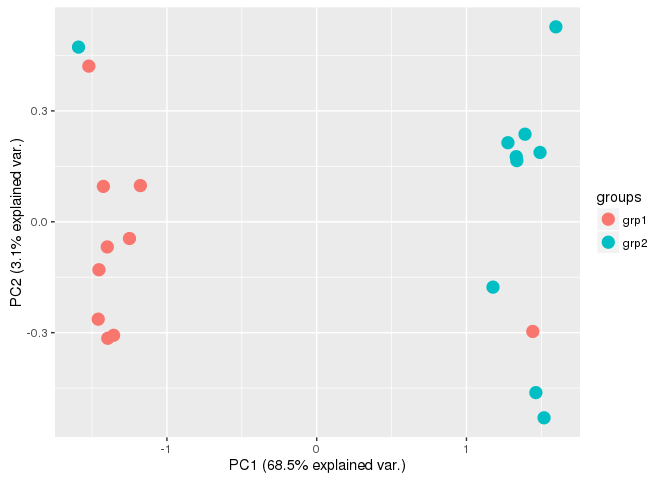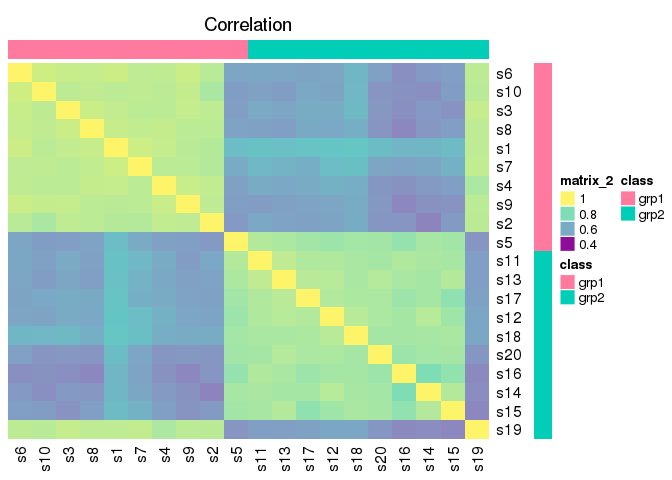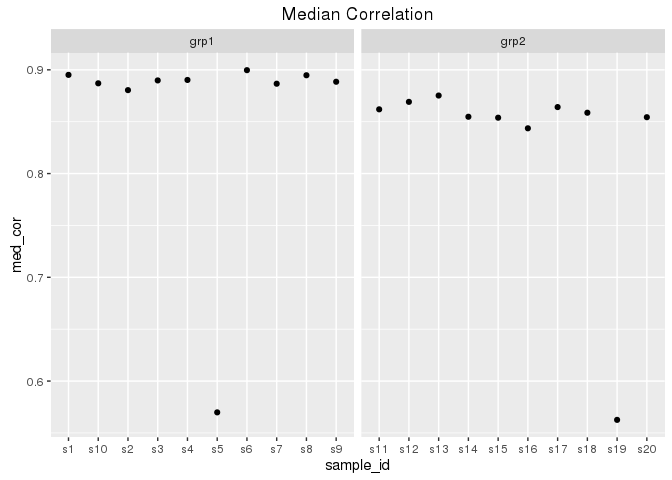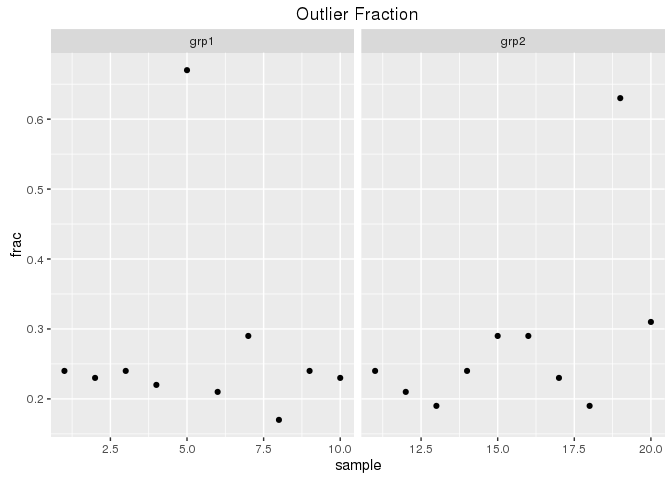Set of useful functions for calculating various measures from data and visualizing them.
Takes a lot of inspiration from Gierlinski et al.,
2015, especially the
median_correlation and outlier_fraction functions.
This readme is documenting functionality as of 818b62f8.
Note that before installing, you will want to install the ggbiplot
package, and at least v1.2.1 of the ComplexHeatmap package. Robert M
Flight maintains a fork of ggbiplot on GitHub because it is not part
of CRAN, and as of July 2, 2015, ComplexHeatmap must be installed from
GitHub:
devtools::install_github("rmflight/ggbiplot")
devtools::install_github("jokergoo/ComplexHeatmap")
Other odd dependencies that may not be present include the dendsort
package, and the viridis package:
install.packages("dendsort")
install.packages("viridis")
This package can be installed by cloning from the GitLab repo:
git clone https://gitlab.cesb.uky.edu/rmflight/visualizationQualityControl.git
cd visualizationQualityControl
R
devtools::install(".", quick = FALSE) # builds the vignette, which you definitely want
Alternatively, you can install it from GitHub in one go:
devtools::install_github("rmflight/visualizationQualityControl", quick = FALSE)
These examples show the primary functionality. We will apply the visualizations to a two group dataset. However, all of the functions are still applicable to datasets with more than two groups. The examples below are for a dataset where there has been a sample swapped between the two groups (i.e. there is a problem!). If you want to see how the visualizations compare between a good dataset and a bad dataset, see the vignette.
library(visualizationQualityControl)
data("grp_cor_data")
exp_data <- grp_cor_data$data
rownames(exp_data) <- paste0("f", seq(1, nrow(exp_data)))
colnames(exp_data) <- paste0("s", seq(1, ncol(exp_data)))
sample_info <- data.frame(id = colnames(exp_data), class = grp_cor_data$class)
exp_data[, 5] <- grp_cor_data$data[, 19]
exp_data[, 19] <- grp_cor_data$data[, 5]
sample_classes <- sample_info$class
pca_data <- prcomp(t(exp_data), center = TRUE)
visqc_pca(pca_data, groups = sample_classes)
Calculate sample-sample correlations and reorder based on within class correlations
data_cor <- pairwise_correlation(t(exp_data), exclude_0 = TRUE)$cor
data_order <- similarity_reorderbyclass(data_cor, sample_classes, transform = "sub_1")
And then generate a colormapping for the sample classes and plot the correlation heatmap.
data_legend <- generate_group_colors(2)
names(data_legend) <- c("grp1", "grp2")
row_data <- sample_info[, "class", drop = FALSE]
row_annotation <- list(class = data_legend)
library(viridis)
library(circlize)
colormap <- colorRamp2(seq(0.4, 1, length.out = 20), viridis::viridis(20))
visqc_heatmap(data_cor, colormap, "Correlation", row_color_data = row_data,
row_color_list = row_annotation, col_color_data = row_data,
col_color_list = row_annotation, row_order = data_order$indices,
column_order = data_order$indices)
data_medcor <- median_correlations(data_cor, sample_classes)
ggplot(data_medcor, aes(x = sample_id, y = med_cor)) + geom_point() +
facet_grid(. ~ sample_class, scales = "free") + ggtitle("Median Correlation")
data_outlier <- outlier_fraction(t(exp_data), sample_classes)
ggplot(data_outlier, aes(x = sample, y = frac)) + geom_point() +
facet_grid(. ~ class, scales = "free") + ggtitle("Outlier Fraction")
To open the vignette giving an example of examining data for quality
control purposes, you should see the quality_control vignette using:
vignette("quality_control", package = "visualizationQualityControl")
This will open the vignette in the help pane in RStudio, which is
often what you want to happen.
Some fake data is stored in grp_cor_data that is useful for testing
the median_correlation function. It was generated by:
library(fakeDataWithError)
set.seed(1234)
s1 <- runif(100, 0, 1)
grp1 <- add_uniform_noise(10, s1, 0.1)
model_data <- data.frame(s1 = s1, s2 = grp1[, 1])
lm_1 <- lm(s1 ~ s2, data = model_data)
lm_1$coefficients[2] <- 0.5
s3 <- predict(lm_1)
s4 <- add_uniform_noise(1, s3, 0.2)
grp2 <- add_uniform_noise(10, s4, 0.1)
grp_class <- rep(c("grp1", "grp2"), each = 10)
grp_cor_data <- list(data = cbind(grp1, grp2), class = grp_class)
library(fakeDataWithError)
set.seed(1234)
n_point <- 1000
n_rep <- 10
# a nice log-normal distribution of points with points along the entire range
simulated_data <- c(rlnorm(n_point / 2, meanlog = 1, sdlog = 1),
runif(n_point / 2, 5, 100))
# go to log to have decent correlations on the "transformed" data
lsim1 <- log(simulated_data)
# add some uniform noise to get lower than 1 correlations
lgrp1 <- add_uniform_noise(n_rep, lsim1, .5)
# add some uniform noise to everything in normal space
sim1_error <- add_uniform_noise(n_rep, simulated_data, 1, use_zero = TRUE)
# and generate the grp1 data in normal space
ngrp1 <- exp(lgrp1) + sim1_error
# do regression to generate some other data
model_data <- data.frame(lsim1 = lsim1, lsim2 = lgrp1[, 1])
lm_1 <- lm(lsim1 ~ lsim2, data = model_data)
# reduce the correlation between them
lm_1$coefficients[2] <- 0.5
lsim3 <- predict(lm_1)
# and a bunch of error
lsim4 <- add_uniform_noise(1, lsim3, 1.5)
# create group with added error to reduce correlation from 1
lgrp2 <- add_uniform_noise(10, lsim4, .5)
# add error in original space
nsim4 <- exp(lsim4)
sim4_error <- add_uniform_noise(10, nsim4, 1, use_zero = TRUE)
ngrp2 <- exp(lgrp2) + sim4_error
# put all data together, and make negatives zero
all_data <- cbind(ngrp1, ngrp2)
all_data[(all_data < 0)] <- 0
grp_class <- rep(c("grp1", "grp2"), each = 10)
grp_exp_data <- list(data = all_data, class = grp_class)



